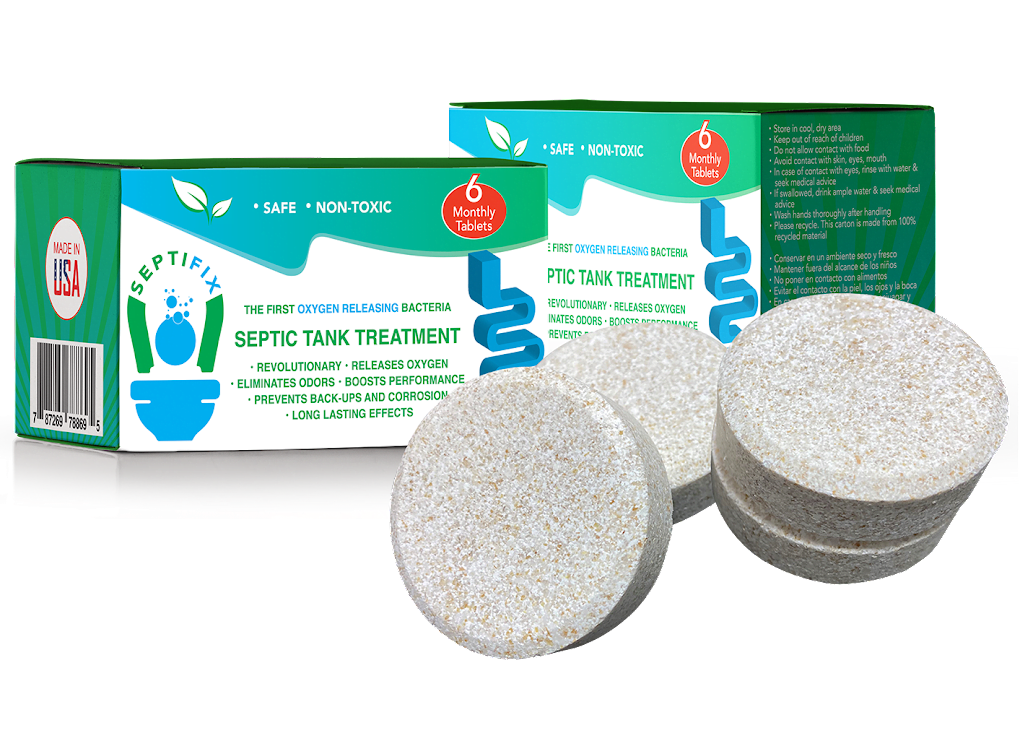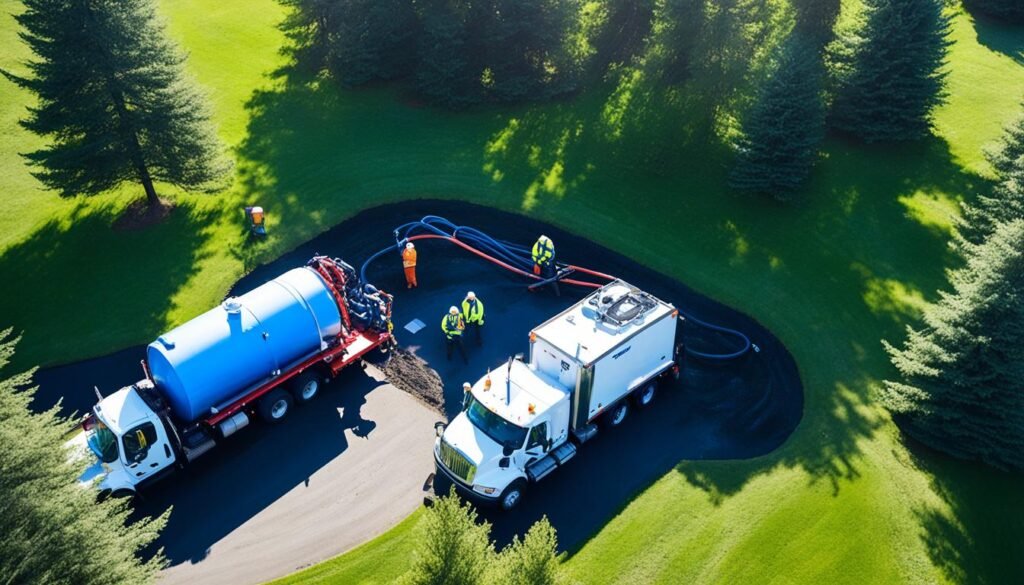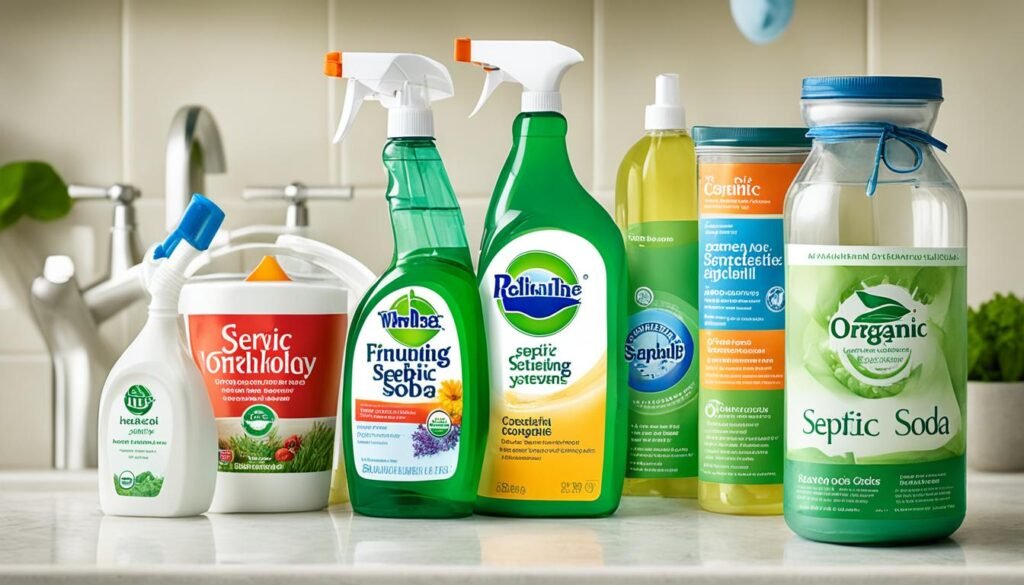Have you ever wondered why some septic systems last for decades and others don’t? In the United States, over 20% of homes have their own septic systems. Knowing how to take care of your septic tank is not just good; it’s necessary. This guide will cover everything you need about septic tank maintenance. We’ll examine how septic tanks work and the best ways to keep yours working well.
Key Takeaways
- Regular maintenance is crucial for the longevity of a septic system, potentially extending its lifespan to over 40 years.
- Pumping a septic tank typically costs between $200 and $600, depending on size and location.
- Common household practices can significantly impact the efficiency and health of your septic system.
- Signs of septic issues often include unpleasant odors and standing water around the tank.
- A septic inspection should be performed every one to two years to prevent costly repairs.
- Understanding the components of your septic system, including baffles and effluent filters, is vital for effective maintenance.
Understanding Your Septic System
Knowing how a septic system works is key for homeowners who use them. A good system manages waste well, keeping us and the environment safe. It’s important to know about the septic tank and its parts.
How a Septic Tank Works
A septic tank separates and treats wastewater in a simple way. Wastewater comes in through a pipe and forms three layers: scum, sludge, and effluent. Bacteria break down the solids into a liquid. Then, the clean liquid goes out to the drain field for more cleaning. Knowing this helps with installing or keeping a tank running well.
Components of a Septic System
The septic system works well, thanks to its parts. The main ones include:

SEPTIFIX will save you hundreds, if not thousands of dollars each year, because your septic system will run smoothly and you won’t have to worry about calling the pumpers or a plumber for a fix!
Click here to save up to 50%
| Component | Function |
|---|---|
| Septic Tank | Holds and treats wastewater by separating solids and liquid. |
| Inlet Baffle | Directs incoming wastewater downward into the tank. |
| Outlet Baffle | Guides treated effluent from the tank to the drain field. |
| Drain Field | Filters and disperses effluent into the surrounding soil. |
| Effluent Filter | Traps solids to prevent clogging in the drain field. |
| Access Ports | Allow for maintenance and inspection of the system. |
Getting to know these parts is key to keeping your system in shape. A well-maintained system keeps our water clean, which is important for everyone’s health and the planet.
Reasons for Regular Septic Tank Maintenance
Knowing why you should maintain your septic tank is vital. It affects the health of your system and property. If you ignore it, you might face big repair bills and health risks from dirty water. By taking care of it, your septic system works better for longer.
Preventing Costly Repairs
Maintaining your septic tank helps avoid sudden, expensive repairs. Without care, your system could leak sewage, get clogged, or smell bad. Fixing these issues can cost a lot. Septic tank repair becomes pricey. But routine checks and pumping it every 3 to 5 years can help you save money. They catch problems early, stopping them from getting worse.
Extending the Lifespan of Your System
Taking care of your septic tank is key to making it last longer. With proper maintenance, your septic tank lifespan can reach many years. This care lessens wear on important parts like the tank and leach field, helping your system work well for more time. Ignoring these tasks could harm the groundwater, which is a danger to the environment and people’s health.
Signs Your Septic Tank Needs Attention
Homeowners should know when their septic tank has problems. Spotting these signs early can avoid big issues later on. Two main signs show your septic system needs help right away.
Odors and Smells
Pay attention if you smell bad odors near your septic tank or drain field. These smells mean your tank might be full or leaking. Ignoring these smells increases your chance of septic failure by 60%.

SEPTIFIX will save you hundreds, if not thousands of dollars each year, because your septic system will run smoothly and you won’t have to worry about calling the pumpers or a plumber for a fix!
Click here to save up to 50%
Dealing with these smells quickly is key to keeping your septic system healthy.
Standing Water Around the Tank
Standing water near your tank or drain field is a warning sign. It suggests your system is overloaded or something isn’t working right. Wet spots in your yard are often linked to septic problems. About 45% of these cases come from standing water issues.
A very green area above the drain field can also signal trouble. This usually means there’s a 70% chance of drain field problems.
Watching for these signs is crucial to keep your septic system working well. Taking quick action helps with maintenance and can save money on future repairs.
Regular Septic Tank Pumping
Pumping your septic tank keeps it working well. Knowing when to do it avoids expensive fixes and makes it last longer. Most homes need it done every 3 to 5 years, but this can change depending on how big your home is and how much water you use.
When to Pump Your Septic Tank
The need to pump your tank depends on your family size and waste amount. Larger families often need their tanks pumped every 2 to 3 years. Watch for signs like slow drains, bad smells, or water pooling near the tank. Ignoring these can cause major problems for 90% of systems.
How Pumping Works
Professionals use special gear to clean out your tank during service. They remove solid and liquid waste, cleaning the tank and allowing them to check for leaks or other problems. Pumping regularly can add 20 to 30 years to your system’s life by avoiding blockages. The cost for this service ranges from $200 to $500. It’s an important investment for your home’s sewage system.
| Household Size | Recommended Pumping Frequency | Average Cost |
|---|---|---|
| 1-2 people | Every 4-5 years | $200-$300 |
| 3-4 people | Every 3-4 years | $300-$400 |
| 5 or more people | Every 2-3 years | $400-$500 |
The Importance of Septic Tank Inspection
Inspecting your septic tank regularly is key to keeping it working well. Inspections help catch issues early before they turn into big problems. It’s not just about emptying the tank; routine checks ensure it lasts longer and works better.
What Professionals Look For
Professionals check several things during an inspection. They look for leaks, cracks, how the baffles are doing, and the sludge level. They also see how well the absorption area works, paying close attention to the soil. Catching problems early can save money and extend the septic system’s life, usually 25 years.
Frequency of Inspections
Experts suggest getting your septic tank inspected every three to five years. How often it happens depends on your household size and tank age. A big family or a high water table might mean more frequent checks. Combining these inspections with pumping every five years keeps your septic system in shape.

SEPTIFIX will save you hundreds, if not thousands of dollars each year, because your septic system will run smoothly and you won’t have to worry about calling the pumpers or a plumber for a fix!
Click here to save up to 50%
| Inspection Level | Description | Typical Cost |
|---|---|---|
| Level 0 | Visual-only inspection | $260 – $420 |
| Level 1 | Limited assessment of the tank | $260 – $420 |
| Level 2 | Thorough tank survey | $260 – $420 |
| Level 3 | Comprehensive inspection with soil assessment | Varies based on location |
Homeowners must follow the recommended inspection timetable. Staying on top of septic tank checks prevents sewage problems and health risks, and it ensures your system runs smoothly and safely.
Best Practices for Septic Tank Cleaning
Keeping your septic system clean is crucial for it to work well. Regular cleaning can prevent expensive fixes and make it last longer. You can hire experts for septic tank cleaning or do it yourself to ensure it runs smoothly.
Using Professional Services
Using professional services means your septic tank gets cleaned with expert knowledge and equipment. Pumping a septic tank is usually between $300 and $600, but it can vary based on the tank’s size. These experts also check for leaks and the thickness of the sludge layer during the pump out. Choosing professionals can greatly lower the chance of big problems that are expensive to fix, costing anywhere from $3,000 to $7,000.
DIY Cleaning Practices
DIY septic maintenance is an option if you like to handle things yourself. Watching what waste enters the system and flushing only toilet paper can keep it healthy. It’s important not to flush things like coffee grounds, eggshells, and cooking oil, which can mess up your system. Also, using appliances that save water can lessen the burden on your septic tank. Avoid harsh cleaners like bleach to protect the good bacteria that break down waste.
Experts often recommend pumping your septic system every three to five years. Following these practices will help keep your septic in top shape, allowing it to last longer and work better.

| Aspect | Professional Services | DIY Maintenance |
|---|---|---|
| Cost | $300 – $600 per pumping | Lower long-term expenses |
| Frequency of Service | Every 3 to 5 years | Regularly monitor and maintain |
| Inspection | Comprehensive inspections | Self-check for obvious issues |
| Recommended Actions | Pumping and professional advice | Avoid harmful materials and chemicals |
| Bacterial Activity | Maintained by professionals | Protected by careful waste management |
Protecting Your Septic Tank and Leach Field
It’s crucial to keep your septic tank and leach field working well for the health of your wastewater system. Avoid heavy loads on the leach field, as too much weight can damage it. Choosing smart landscaping around your septic system is also key to its longevity.
Avoiding Heavy Loads on the Leach Field
Don’t let heavy traffic go over the leach field. It can lead to expensive fixes. Keep cars and heavy machines off of it. Also, don’t build permanent things there. Doing these things helps your septic tank last longer.
Proper Landscaping Recommendations
Good landscaping around your septic system is important. Use plants like grass with shallow roots, which won’t mess with your leach field. Also, make sure gutter water flows away from the leach field, which prevents flooding and helps with drainage. These tips keep your septic system safe.
Managing What Goes Down the Drain
Homeowners have a big job keeping their septic systems healthy. It starts with what they let go down the drain. Using the right products helps keep the necessary bacteria working well, which means waste breaks down like it should. Be careful only to flush things that are safe for the system. Avoid anything that could throw off the balance.

SEPTIFIX will save you hundreds, if not thousands of dollars each year, because your septic system will run smoothly and you won’t have to worry about calling the pumpers or a plumber for a fix!
Click here to save up to 50%
Safe Household Products for Septic Systems
Choosing the right products is key for septic care. Some cleaners are made to be safe for the environment and won’t harm the good bacteria in your tank. For instance, biodegradable soap, vinegar, and baking soda are great choices. They clean well without dangerous chemicals. Using these safe options helps the bacteria thrive. That makes sure waste gets broken down properly.
Avoiding Harmful Substances
Knowing what not to use is just as important. Certain things like fats, oils, and grease can cause big problems. They can clog pipes, which might lead to system failure. Also, keep toxic chemicals like paint and gasoline away. They can pollute your tank and even the groundwater. Don’t flush non-biodegradable items such as plastics and cat litter. They fill the tank too fast and cause trouble. Avoiding these keeps your septic system healthier and lowers the risk of issues.

| Safe Household Products | Harmful Substances to Avoid |
|---|---|
| Biodegradable soap | Grease and fats |
| Vinegar | Paint and solvents |
| Baking soda | Gasoline |
| Septic-safe cleaners | Insecticides and pesticides |
| Essential oils | Non-biodegradable materials (e.g., plastics) |
Maintaining Healthy Bacteria Levels
Healthy bacteria are key for a septic tank to work properly. They break down waste and keep the system balanced. To avoid expensive problems, it’s vital to ensure these bacteria are always present. Special products help with this.
How Bacteria Help Your Septic System
Bacteria break down organic waste into simpler, safe substances, crucial for efficient waste management. Without enough bacteria, issues like sludge and bad smells can occur. Getting your tank pumped every three to five years helps keep everything working smoothly.
Using Bacteria Additives Safely
It is important to choose safe bacteria additives. Avoid products with harsh chemicals, as they can damage your septic system’s natural processes. Use yeast monthly and natural cleaners like baking soda and vinegar, which support healthy bacteria without harmful effects.
| Aspect | Details |
|---|---|
| Frequency of Pumping | Every 3 to 5 years |
| Monthly Yeast Addition | 1/4 ounce packet recommended |
| Cost of Pumping | $100 to $300 per routine pump |
| Natural Cleaner Options | Baking soda and vinegar |
| Common Chemical Killers | Bleach and ammonia-based cleaners |
Common Myths About Septic Tanks
Many people believe false things about septic tanks. These septic tank myths and septic system misconceptions can lead to bad choices. Knowing the truth is essential for taking good care of your system. It helps your septic system work well for a long time and saves money on repairs.
Debunking Misconceptions
Some people think septic systems don’t need much care. But it’s best to pump them every 2 to 3 years. If you don’t, clogs might happen, making the system work poorly. Also, using household bleach can harm your system. Just one cup can destroy the helpful microbes in a 1,000-gallon tank.
Understanding the Realities of Maintenance
Regular maintenance is very important for septic tanks. A good system can last more than 20 years, and sometimes up to 49 years. If there are clogs, procedures like jetting can fix them. It’s also good to know that products promising to stop the need for pumping often don’t work as promised.
| Myth | Reality |
|---|---|
| Septic systems don’t require regular maintenance. | Regular pumping every 2-3 years is essential. |
| Bleach and similar products are safe for septic systems. | Bleach kills beneficial microbes in the tank. |
| Jetting is only for emergency situations. | Jetting can restore and maintain septic function effectively. |
| All maintenance products are beneficial. | Many claiming “secret” benefits lack evidence. |
Understanding and busting these septic tank myths is crucial. It helps homeowners take better care of their systems. With the right knowledge, you can avoid expensive fixes and keep your septic system healthy for a long time.

SEPTIFIX will save you hundreds, if not thousands of dollars each year, because your septic system will run smoothly and you won’t have to worry about calling the pumpers or a plumber for a fix!
Click here to save up to 50%
Conclusion
Taking good care of your septic tank is crucial for its effective operation and long life. This guide’s advice, like regular checks and pumping when needed, can help you avoid big problems. Also, watch out for warning signs like bad smells or slow drains to keep your septic tank healthy.
Ignoring your septic system can lead to expensive fixes and health risks. Unsafe water from a neglected system is especially dangerous for kids and pregnant women. Staying on top of maintenance can prevent diseases such as E. coli and Salmonella from spreading.
Homeowners need to become dedicated to regular inspections and proper waste handling. By understanding how vital septic care is and acting to maintain their systems, they safeguard their homes and the environment, bringing them peace of mind for the future.
FAQ
How often should I have my septic tank pumped?
Experts suggest pumping your septic tank every 3 to 5 years. But this depends on your tank’s size, how many people live in your house, and the solid waste amount.
What are the signs that my septic tank needs maintenance?
Watch for signs like bad smells around the tank or drain field and standing water. Also, if the grass near the tank is unusually green and lush, your system might need attention.
What are the components of a septic system?
A septic system has a septic tank, an outlet baffle, and a leach or drain field. Each part is key in cleaning and filtering your home’s wastewater.
Can I use cleaning products in my septic system?
Yes, but choose septic-safe cleaners. Avoid harsh chemicals. They can harm the bacteria in your tank that breaks down waste.
How can I extend the lifespan of my septic system?
To make your septic system last longer, pump it every 3 to 5 years. Also, do yearly checks and be mindful of what you put down the drain.
What should I do if I notice bad odors coming from my septic tank?
Bad smells may mean your tank is full or has leaks. It’s key to get a pro to check your tank and fix any problems right away.
What are common myths about septic tanks?
Some think septic tanks don’t need upkeep or that pumping them is wasteful. But, regular maintenance is crucial to avoid big repair costs later.
What happens during a septic tank inspection?
Inspectors look for leaks, cracks, and how the baffle is doing. They also check the sludge levels. This helps find issues before they get worse.
Is it safe to plant trees near my septic system?
Avoid planting trees or big shrubs near your septic system, especially the leach field. Their roots can disrupt the system. Choose plants with shallow roots to prevent damage.


